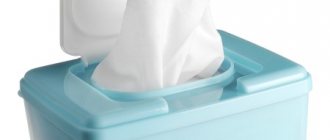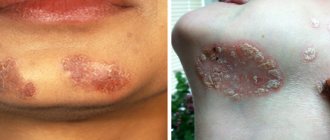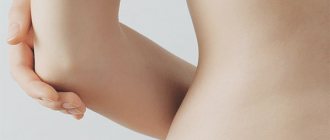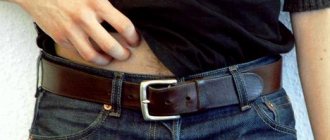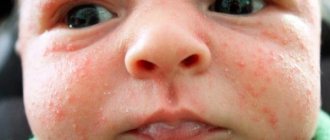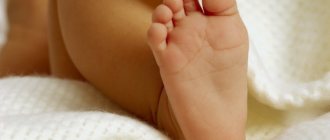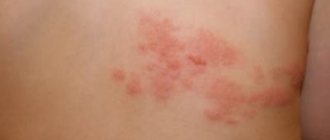Goose bumps in a child is a phenomenon that almost all parents have encountered at least once. Caring mothers and fathers cannot help but pay attention to this change in the condition of their baby’s skin. Having noticed goose bumps on a child, some parents experience great concern, while others believe that such a rash does not pose a danger and attribute everything to the physiological characteristics of the body. What exactly is this problem?
Goose bumps in a child (popularly this phenomenon is often called goosebumps) are small bumps the color of the patient’s skin that appear on the arms, especially on the elbows and shoulders, buttocks, and thighs. In some cases, goose bumps can even be found under the lower eyelids. In medicine, this phenomenon is called follicular hyperkeratosis. Typically, such skin changes are short-term and manifest themselves as a protective function of the body. However, when goose bumps persist for a long time, it may indicate the presence of serious diseases. Goose bumps on the child’s legs, abdomen and back indicate serious problems with the baby’s health.
External features and mechanism of manifestation
Goose bumps do not always indicate dermatological problems
In some pathological conditions, the skin becomes covered with goosebumps. They are not inflamed and do not change color. Doctors call this keratosis pilaris or keratosis pilaris.
Small tubercles are the result of excessive synthesis of horny substance in the layers of the skin and a violation of the exfoliation of particles. Most often this occurs due to a lack of vitamins.
The goose bumps do not disappear until the body returns to its previous normal state. It is necessary to find out the cause of goose bumps on the knees and undergo a course of treatment.
Diagnostics
If you suspect that goose bumps are a symptom of a disease or other serious problem, you should not put off going to the doctor or try to take any independent action.
The diagnosis of follicular hyperkeratosis is always made by a dermatologist, however, to identify the causes and prescribe the correct treatment, it will be necessary to consult with specialists such as a pediatrician, endocrinologist and gastroenterologist. In many cases, several laboratory tests are also performed.
Possible reasons
If goose bumps appear from fright or hypothermia, the symptom is temporary and passes quickly. In this case, there is nothing to worry about. However, there are also special pathological reasons.
Factors that can cause goose bumps:
- Pathologies of the endocrine system.
- Deficiency of vitamins B, A, E and C.
- Features of metabolism.
- Genetic predisposition.
The symptom also appears when the rules of hygiene and skin care are systematically violated.
What to do if you itch
If a rash is causing discomfort to a child, adults should be careful to ensure that the child does not scratch the pimples. The only thing that can be done to help the baby before the pediatrician prescribes the correct treatment is to wipe the affected areas of the skin with cool filtered water as often as possible. This will help temporarily reduce itching, relieve swelling, and prevent your child from scratching.
Young parents mistakenly ignore small pimples in children, most often appearing on the arms and legs. Such a rash may be a symptom of a serious illness that requires prompt medical attention. To avoid complications, adults are not recommended to self-medicate their child, but to immediately contact a qualified pediatrician.
Article design: Vladimir the Great
Treatment methods for adults and children
Goose bumps in children appear due to dry air
If a vitamin deficiency is detected, the doctor will prescribe a course of medications to replenish the balance of microelements in the body.
To exclude deviations in the functioning of the endocrine system, it is necessary to take hormone tests.
Ointments and lotions based on acid, hormonal or moisturizing components will help get rid of goose bumps on the knees:
- Ointment "Akriderm SK".
- "Salicylic alcohol".
- Lotion "Belosalik" and others.
The dosage, frequency of administration and duration of treatment will be prescribed by the doctor depending on the complexity of the situation and the age of the patient.
Goose bumps on a child’s knees often occur as a result of improper care and dry air. In this case, daily bathing and a course of baths with string or celandine will help.
For adult patients, there are cosmetic procedures that will help cope with the problem and avoid relapses in the future.
| Method name | Mechanism of action / composition of the product used | Expected Result |
| Peeling with acids | They use products based on fruit acids, a vitamin cocktail (vitamins A, C, B), and enzymes. Drugs should be selected carefully, as they are quite aggressive. | Coarsened, dead cells of the epidermis are exfoliated. The skin is renewed, becomes smooth, soft, enriched with vitamins, and acquires a healthy color. |
| Peeling with salt or coffee | The basis of the composition is sea salt or ground coffee. You can add oils and vitamin cocktails. During the massage movements, abrasive elements mechanically act on dead skin cells and exfoliate them. | The skin is cleansed, smoothed, and becomes soft. There are contraindications. It is important to do an allergy test first. |
| Wraps | They use seaweed, honey, chocolate. | The products nourish, moisturize and smooth the skin. |
| Anticellulite massage | Use honey and anti-cellulite cosmetics. | The skin becomes even, smooth, and toned. Contraindication: varicose veins in the legs. |
How to treat
Approaches to treating rashes depend on the age of the child.
To treat a newborn baby's skin from acne, the mother's diet will have to be changed. To get rid of pimples, you must first determine the cause of their appearance. To eliminate itching and burning, external agents are prescribed:
- For diaper rash, Bepanten cream and powder are prescribed.
- Bathing with the addition of a decoction of herbs that has an anti-inflammatory effect: string, chamomile, calendula, oak bark.
- If the pimples are of allergic origin, a diet is prescribed for the mother if the child is breastfed, or the baby's complementary foods are changed.
- Treatment of rashes with furatsilin solution.
- Antihistamines.
- If pimples are infectious, antibiotics are prescribed.
- Acne caused by chickenpox is treated with brilliant green. It is also necessary to take antipyretic drugs.
- To restore their skin, children undergo a course of vitamin therapy.
- In some situations, the child is hospitalized.
Since the appearance of acne can be accompanied by a serious illness, parents should definitely take their baby to the doctor.
Medication
Considering the types of acne, the child can be treated accordingly. For severe rashes, antihistamines are prescribed.
When the rash is accompanied by a high temperature, you will need the help of a doctor. Such pimples are a sign of infection and can be eliminated with antibiotics or antiviral drugs.
At home
If the rash is allergic in nature, the influence of the provoking factor must be eliminated. A nursing mother should reconsider her diet.
Mothers during breastfeeding are not recommended to consume the following foods:
- red fruits;
- chocolate;
- citrus fruit;
- Exotic fruits;
- spices;
- dairy products.
You should limit your diet to fish and chicken, as they are potentially allergenic. When introducing a new product to the menu, it is necessary to monitor the child’s reaction.
When the baby begins to eat on his own, complementary foods should be introduced correctly in consultation with the pediatrician.
ethnoscience
There are many traditional medicine recipes for treating childhood acne.
Most popular recipes:
- Aloe juice. The leaves are washed with boiled water and placed in a cool place for 10 days. After this, juice can be squeezed out of them, which must be used to wipe the child’s skin daily. It is made from aloe and a lotion by adding boiled water to the juice of the plant in a ratio of 1:5. Before applying the product to the skin, it should sit for 1 hour, then boil for 2-3 minutes.
- Plantain. Plantain juice is used to wipe the child's damaged skin. The crushed leaf can be applied directly to the pimple.
- Sagebrush. To prepare the tincture 2 tbsp. spoons pour 300 ml of boiling water. The resulting product is effective in the form of compresses and lotions.
- St. John's wort. A decoction of St. John's wort is prepared from 1 tbsp. l. leaves and flowers of the plant and a glass of boiling water. The mixture is boiled for 10–15 minutes and filtered. The product can be used to wipe pimples on a child’s face.
- Calendula. The plant will help prevent the appearance of scars on the child's skin. The recipe for the remedy is as follows: 1 tsp. Calendula tinctures are mixed with 1 tsp. honey and pour a glass of water.
- Pumpkin. Pimples on the skin can be removed with a piece of raw pumpkin.
- Birch buds. A decoction is prepared from them: 1 tbsp. l. kidneys are poured with a glass of boiling water, after which it boils for 15-20 minutes.
- Celandine. A decoction prepared from it will cope with the rash, which is caused by the accumulation of pus. To do this, take 2 tbsp. l. plants and 0.5 liters of boiling water. The product is infused for 2 hours and filtered.
- Sage and chamomile. These are the most harmless herbs for treating acne in children. They have disinfecting properties.
All these remedies can be taken only after consultation with a pediatrician. Parents should take into account that each child’s body is individual and can react in a special way to traditional medicine. The main danger of medicinal herbs for a child is allergies.
Folk recipes
Salt and almond oil make the skin velvety, soft
If the cause of goose bumps on the knees is not associated with pathology, treatment with folk remedies is the best option.
- Compress made from a decoction of birch buds. Heat 3-4 degrees in a water bath. birch buds in half a liter of water for 10 minutes. Moisten a towel with the broth and apply to problem areas. It is enough to apply a compress 2-3 times a week.
- Scrub with salt and almond oil. 500 gr. mix salt with 25–35 drops of oil. Treat your knees 2-3 times a week. After the procedure, rinse off the composition and lubricate the skin with moisturizer.
It is important to shower daily and avoid drying out your skin. If the cause of goosebumps is metabolism, you need to balance your diet and give up bad habits.
The main factors causing rashes in children
- teething. A common reason why acne appears on a child’s face. Often their localization is formed around the mouth and on the chin. This is due to the fact that when teeth begin to actively erupt in children, there is a strong secretion of saliva. When this process is completed, acne also disappears;
- manifestations of allergies. Red pimples on a child’s body may be allergic manifestations. The appearance of these rashes occurs abruptly and is always accompanied by itching. When, in addition to the appearance of acne, the baby sneezes and has a runny nose, then there is no doubt that allergies have caused skin irritation. It is enough to exclude the allergen, and the pimples will go away.
- milliaria (prickly heat). Small babies indicate the presence of prickly heat;
- reaction to the administered vaccine. They may differ in individual manifestations and be accompanied by a rash. If rashes appear after vaccination, you should immediately consult a doctor;
- failure to maintain cleanliness. The skin of babies is particularly delicate and sensitive, and it requires scrupulous care and keeping clean;
- careful care and hygiene. If the dermis is highly contaminated, it can cause inflammation and pustules in the child. In this case, there is a possibility of infection;
- exposing the skin to chapping, sunburn, frostbite. Temperature and climate sometimes have an adverse effect on children's dermis. These circumstances must be foreseen and special protective equipment must be applied;
- acnemorphic manifestations. These rashes in infants occur if the mother took a course of medications during pregnancy: steroids or drugs containing lithium or phenytoin. This is also a manifestation of some illnesses of the mother. Expressed by the child.
Additional factors
- reaction caused by insect bites. The presence of red pimples with swelling, the location of which is uneven, but on different parts of the body, may indicate insect bites. To avoid this, it is necessary to use repellents, since sometimes wounds left by insects can cause severe allergic reactions and some diseases, parasites. Red pimples on a child’s body can be of different sizes;
- . This disease is characterized by the fact that the skin becomes infected with microorganisms called streptococci. This disease has various forms. Sometimes it manifests itself in the form of watery pimples in a child that are red in color. If it is not treated in time, it can degenerate into large scaly sores;
- vesiculipustulosis (staphylococcal infection). If staphylococci become the cause of infection, then white pus appears on the child’s body in various places. White pimples on a child’s face can be very dangerous, so you should immediately consult a doctor;
- childhood infectious diseases (chickenpox, meningitis, measles, rubella, etc.) They can be accompanied by the appearance of acne, localized throughout the body. In addition to rashes, in such situations symptoms are observed in the form of fever, chills, weakness, painful sensations in the throat;
- imbalance in the intestines. Acne appears on the child’s face, the eyebrows, the scalp area with hair, and sometimes the entire surface of the body suffer. Areas of the dermis that are affected by small rashes often itch;
- diabetes. A sign of this disease is that they are located on the child’s genitals. The cause of the rash is increased sugar in children's urine;
- Keratosis appears as rough, rough skin in small pimples. They are usually located on the back and side of the hand;
- puberty. Changes in hormones provoke the appearance of red, black and white acne.
The surface that such rashes usually affect is the face. They can manifest themselves in the form of blackheads, acne, open and closed comedones. As the child gets older, these manifestations disappear, but at this time he must be taught to carefully care for his skin.

